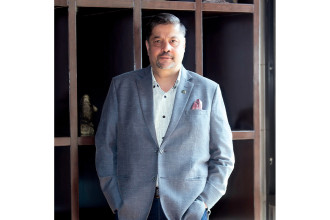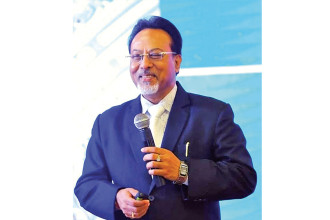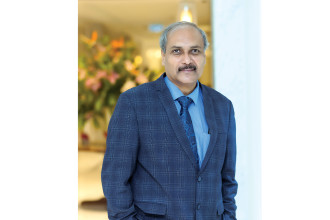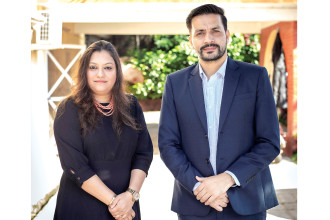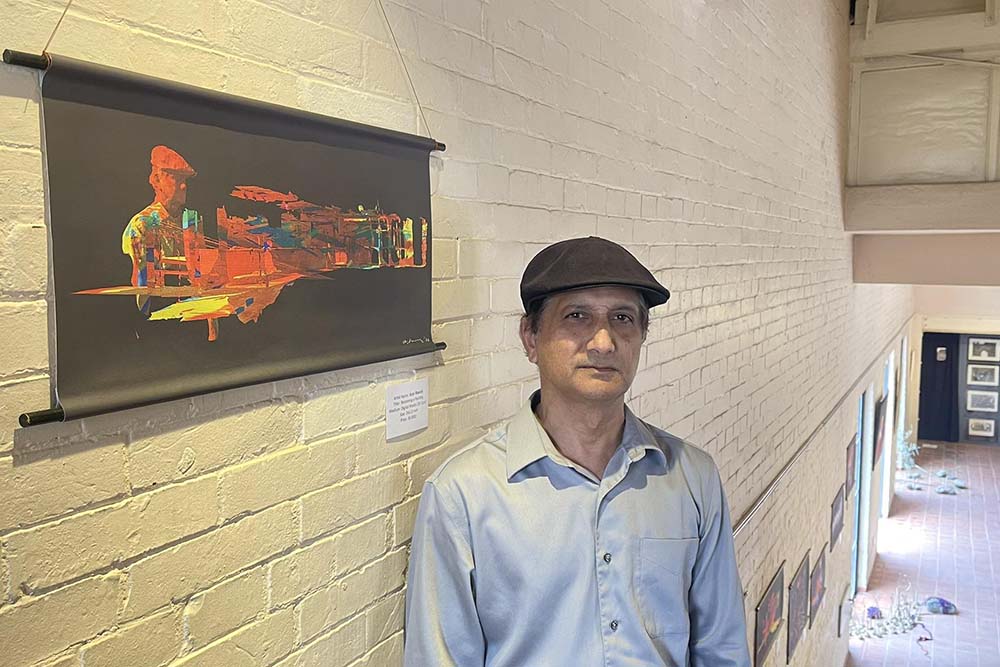
Azyz Sharafy teaches Studio/Electronic Arts, and Graphic Design at Washburn University, Topeka, Kansas, in the USA. He has been teaching at Washburn University since 1998. He says, "To enhance students' learning experience and broaden their creative horizons, I introduced courses in visual effects, digital painting, 3D painting, augmented reality (AR), virtual reality (VR), and even ventured into the realm of artificial intelligence (AI). By integrating these technologies into the curriculum, I aimed to provide my students with a comprehensive skill set that would prepare them for the demands of the contemporary art industry." Prajwal Nepali of Business360 caught up with Sharafy, who visited ‘LIVING WITH ARTS IN NEPAL’, a highly anticipated international art exhibition, at The Targaon Museum in Kathmandu. Excerpts:
Could you tell us about your background and how you became interested in the integration of technology and innovation in art?
I have always had a deep interest in fine arts and creative painting ever since I was a child. My passion for art led me to pursue a Master's degree from MS University of Baroda, India, where I honed my artistic skills and developed a strong foundation in traditional art forms. Later, I embarked on another Master's programme in art education in Canada, which broadened my perspective on the importance of art and education in society. When I first encountered technology, particularly computers, I must admit that I was a bit apprehensive. It was unfamiliar territory for me, and I wasn't sure how it could intersect with my artistic pursuits. However, as I delved deeper into the realm of computers and digital art, I found myself increasingly drawn to its creative potential and possibilities. Inspired by the fusion of technology and art, I began exploring the realm of 3D art and animation. The ability to create immersive digital environments and bring my artistic visions to life in ways that were previously unimaginable fascinated me. It was a turning point in my artistic journey, as technology opened up new avenues for self-expression and experimentation. As my interest in technology grew, I took on the role of a teacher at a university, where I could not only share my knowledge and passion for art but also dive deeper into the integration of technology and innovation in art education. I devoted myself to learning various technological tools and techniques, constantly pushing the boundaries of what was possible and encouraging my students to do the same. Working tirelessly to expand my understanding of technology in art, I delved into coding, digital design, and multimedia production. The more I immersed myself in these areas, the more I realised the transformative potential they held for artists and the art world as a whole. Technology became an integral part of my artistic practice, enabling me to create interactive installations, immersive experiences, and digital artworks that pushed the limits of traditional artistic mediums.
Today, I am passionate about the integration of technology and innovation in art. It has become an inseparable aspect of my creative process and has enabled me to explore new frontiers, collaborate with other artists, and engage with audiences in innovative ways. I firmly believe that the fusion of art and technology has the power to inspire, challenge, and shape the future of artistic expression. Through my journey, I have come to embrace technology as a tool that enhances and expands artistic possibilities rather than replacing traditional art forms. It has allowed me to bridge the gap between the traditional and the contemporary, creating a harmonious blend of the two. I am excited to continue exploring the ever-evolving relationship between technology and art, pushing boundaries, and discovering new avenues of creative exploration."
What motivated you to introduce technology-based courses in the Art Department at Washburn University?
My motivation to introduce technology-based courses in the Art Department at Washburn University stemmed from a desire to provide my students with the best possible education and equip them with the skills needed to thrive in a rapidly evolving artistic landscape. When I first joined the Art Department, I observed that the curriculum primarily focused on basic graphic design and had limited offerings in animation and video. Recognising the growing influence of technology in the art world, I saw an opportunity to expand the course offerings and introduce my students to cutting-edge tools and techniques. To enhance the students' learning experience and broaden their creative horizons, I introduced courses in visual effects, digital painting, 3D painting, augmented reality (AR), virtual reality (VR), and even ventured into the realm of artificial intelligence (AI). By integrating these technologies into the curriculum, I aimed to provide my students with a comprehensive skill set that would prepare them for the demands of the contemporary art industry. My motivation behind these efforts was rooted in a genuine passion for nurturing creativity and empowering my students. I firmly believe that technology has the potential to enhance artistic expression, facilitate new forms of storytelling, and push the boundaries of traditional art mediums. By introducing technology-based courses, I wanted to give my students the opportunity to explore and experiment with these innovative tools, allowing their creative visions to flourish.
Furthermore, I was motivated by a desire to equip my students with the skills that are highly sought after in today's digital age. The art industry is constantly evolving, with technology playing an increasingly prominent role. By providing my students with knowledge and proficiency in these areas, I aimed to enhance their career prospects and ensure they were well-prepared to navigate the intersection of art and technology. Ultimately, my motivation to introduce technology-based courses was driven by a commitment to providing my students with the best education possible. I wanted to equip them with the tools, knowledge, and creative mindset needed to excel in their artistic endeavours and embrace the limitless possibilities that technology offers. It is my firm belief that by nurturing their creativity and embracing technological advancements, my students can lead fulfilling lives and make significant contributions to the art world."
How do you believe technology has impacted the field of art and design, and what opportunities has it created for artists and students?
Technology has undoubtedly made a profound impact on the field of art and design, transforming the way artists create, exhibit, and engage with their audiences. Over time, technology has seamlessly integrated itself into the realm of art, revolutionising traditional practices and opening up a world of new possibilities. In the past, art and technology were often perceived as separate entities. However, with advancements in technology, art has embraced digital tools and techniques, creating a fusion that has reshaped the artistic landscape. The widespread availability of smartphones with high-quality cameras, for instance, has made it easier than ever for individuals to capture and share images, expanding the accessibility of visual arts. The integration of technology in art and design has become an integral part of our lives. Artists now have a wealth of opportunities to explore and leverage these advancements to create impactful and innovative works. One such avenue is the video gaming industry, which blends art, storytelling, and interactive experiences. Artists can contribute their skills to game design, character development, world-building, and creating immersive visual environments.
Additionally, technology has given rise to new forms of artistic expression, such as interactive art and generative art. Interactive art engages the viewer in a participatory experience, blurring the lines between the creator and the audience. Through the use of sensors, motion tracking, and interactive installations, artists can create immersive and engaging environments that invite viewers to become active participants. Generative art, on the other hand, leverages algorithms, artificial intelligence, and computational processes to create dynamic and ever-evolving artworks. Artists can programme algorithms to generate visual compositions, music, or animations, resulting in artworks that are continuously changing and adapting. Digital art has also emerged as a prominent medium, offering artists a vast canvas for their creativity. With digital tools and software, artists can explore new techniques, experiment with different visual effects, and push the boundaries of traditional art mediums. The digital realm allows for endless possibilities, enabling artists to create works that seamlessly blend the real and the virtual. These advancements in technology have created an array of opportunities for artists and students alike. Artists can explore diverse mediums, collaborate with professionals from various disciplines, and reach global audiences through online platforms. For students, technology provides an immersive learning experience, enabling them to acquire skills in digital art, animation, virtual reality, and more, opening up career paths in various creative industries. Technology has truly had a transformative impact on the field of art and design. It has integrated seamlessly into artistic practices, offering new avenues for creative expression and providing artists and students with a multitude of opportunities. As technology continues to evolve, artists will have even more tools at their disposal, pushing the boundaries of what is possible and inspiring the next generation of artistic visionaries." 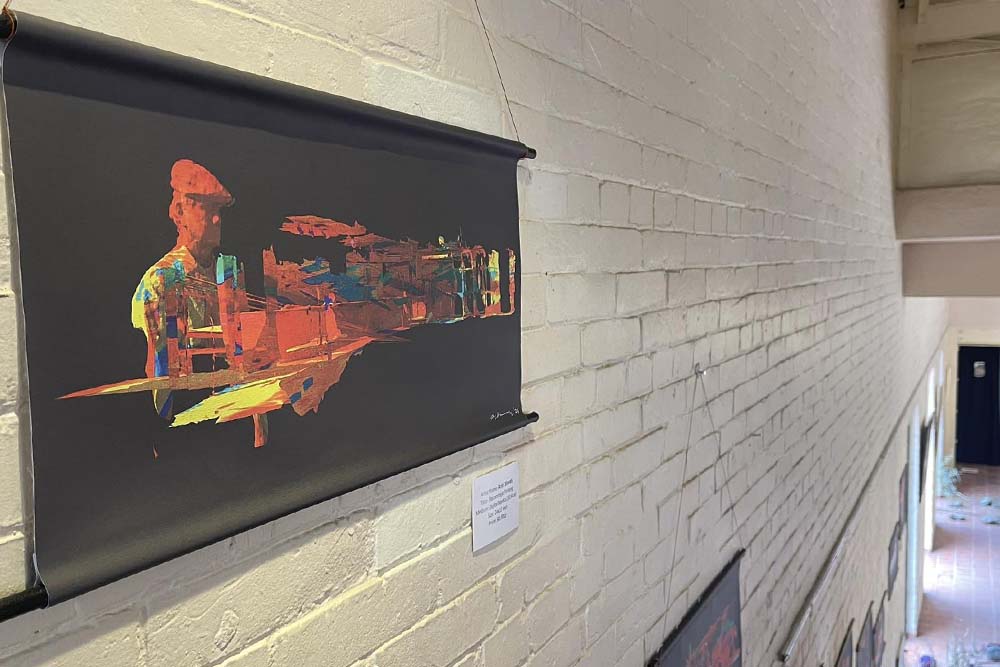 Tell us about the specific courses you teach in the Studio/Electronic Arts and Graphic Design programmes. What skills and knowledge do students gain from these courses?
Tell us about the specific courses you teach in the Studio/Electronic Arts and Graphic Design programmes. What skills and knowledge do students gain from these courses?
In the Studio/Electronic Arts and Graphic Design programmes, we offer a diverse range of courses that aim to equip students with a comprehensive set of skills and knowledge necessary for success in the ever-evolving field of art and design. One of the foundational courses we teach is Drawing, which lays the groundwork for students to develop their drawing abilities. This course helps students refine their technical skills, enabling them to accurately represent objects and scenes. Drawing serves as a fundamental skill in art and design, providing a strong basis for further exploration and creative expression. In the realm of graphic design, we offer a course called Typography, where students delve into the art and science of arranging typefaces. They learn to effectively utilise typography as a visual element in design, considering factors such as readability, hierarchy, and aesthetics. This course helps students develop an eye for detail and a keen understanding of how typography influences communication and visual impact. Packaging and web design courses introduce students to the practical aspects of designing for specific mediums. In these courses, students learn to create visually appealing and functional packaging designs that effectively communicate brand messages. They also explore the principles and techniques involved in designing user-friendly and aesthetically pleasing websites, considering factors such as layout, navigation, and responsiveness. As technology continues to shape the artistic landscape, we offer courses in VR and AR. These courses immerse students in the world of interactive and experiential art, where they learn to create captivating and interactive virtual or augmented environments.
Students gain practical skills in designing and developing immersive experiences that merge the digital and physical realms. Digital painting is another course that provides students with the tools and techniques necessary to create stunning digital artwork. They learn to use digital brushes, layers, and various effects to simulate traditional painting techniques digitally. This course enhances their proficiency in digital art and allows for greater experimentation and flexibility in their creative process. Courses in gaming and animation introduce students to the exciting world of interactive storytelling and character design. They learn the principles of game design, animation techniques, and the technical aspects of bringing characters and worlds to life. Students gain skills in conceptualising, storyboarding, animating, and creating captivating visuals for various platforms. Special effects and AI courses offer students the opportunity to explore advanced techniques in visual effects and the integration of AI in art and design. They delve into the realms of digital manipulation, compositing, and advanced rendering, acquiring skills to create stunning visual effects. Additionally, the AI course introduces students to the possibilities of using AI in the creative process, such as generative art or AI-assisted design. Throughout these courses, students develop technical skills and also cultivate an artistic approach, allowing them to express their creativity and emotions through their work. Moreover, these courses emphasize professionalism, teaching students how to meet deadlines, work collaboratively, and present their work effectively. Students gain a comprehensive understanding of the art and design industry. Moreover, the course equips them with the necessary skills and knowledge to thrive in their careers and make meaningful contributions to the field.  What are the challenges you've encountered in integrating technology into art education, and how have you addressed them?
What are the challenges you've encountered in integrating technology into art education, and how have you addressed them?
Integrating technology into art education has presented its fair share of challenges, and I have encountered some key hurdles along the way. One of the challenges has been staying updated with the ever-evolving software and technologies in the field. The rapid pace of technological advancements means that new tools and software are constantly emerging. It can be a challenge to keep up with these developments and ensure that students have access to the latest information and resources. Additionally, making students aware of the technical growth and the potential that technology offers in the artistic realm has been a challenge. Some students may be reluctant to embrace technology as part of their creative process. It requires effort to educate them about the benefits and possibilities that technology can bring to their artistic practice.
Furthermore, collaborating with colleagues who may not be familiar with these new technologies and tools can also be a challenge. Introducing novel concepts and approaches can sometimes meet with scepticism or resistance. It is essential to bridge the gap and facilitate understanding among colleagues, fostering an environment of openness and shared learning. To address these challenges, I have adopted a proactive approach. Firstly, I recognise the significance of staying updated with the latest software and technology trends. I have dedicated time and effort to continuously educate myself about new tools, techniques, and software applications relevant to the field of art and design. By doing so, I ensure that I can provide my students with relevant and up-to-date knowledge. In terms of making students aware of the technical growth, I have taken a two-fold approach. Firstly, I integrate technology into the curriculum in a way that demonstrates its practical applications and benefits. By showcasing examples of successful projects, sharing case studies, and facilitating hands-on experiences with technology, I help students understand the value it brings to their artistic journey. Secondly, I foster an environment of exploration and experimentation, encouraging students to step out of their comfort zones and embrace technology as a tool for artistic expression. Through assignments, projects, and open discussions, I create opportunities for students to engage with technology and discover its potential firsthand. By nurturing their curiosity and providing guidance, I help them overcome their initial hesitations and embrace the opportunities that technology offers. To address the challenges of working with colleagues who may be unfamiliar with these new technologies, I have approached the situation with patience, empathy, and a willingness to collaborate. I have been proactive in sharing my knowledge and experiences and organising workshops or training sessions to introduce colleagues to new tools and techniques.
By fostering an environment of open dialogue and providing support, I strive to create a collective understanding and appreciation for technology's role in art education. While there have been challenges in integrating technology into art education, I have approached these hurdles as opportunities for growth and development. By staying updated, educating students, and collaborating with colleagues, I strive to create an environment where technology becomes a valuable tool that enhances artistic expression and expands the possibilities for students in their creative journeys.
How do you foster creativity and artistic expression while incorporating technology into your teaching methods?
Fostering creativity and artistic expression while incorporating technology into my teaching methods is a priority for me. I believe in the importance of opening up students' minds to new experiences and approaches that go beyond their comfort zones. To achieve this, I encourage students to embrace experimentation and exploration. I create a supportive environment where they feel comfortable taking risks and pushing the boundaries of their creativity. By incorporating technology, I introduce them to new tools and techniques that can enhance their artistic expression. I strive to provide a balance between structure and freedom in the classroom. While there may be guidelines and learning objectives, I also allow space for students to express their unique artistic voices and explore their personal interests. This freedom empowers them to take ownership of their creative process and develop their artistic identities. Incorporating technology in teaching methods provides students with a broader range of possibilities for creative expression. It opens up new avenues for them to explore different mediums, experiment with various digital tools, and merge traditional artistic techniques with modern technologies.
By integrating technology in this way, I help students discover new ways of communicating their ideas and stories. Moreover, I encourage interdisciplinary approaches and collaboration among students. By fostering connections between art and other fields such as technology, science, or literature, I inspire students to think beyond traditional boundaries and find innovative ways to express their artistic visions. This interdisciplinary approach cultivates a rich and diverse creative environment that sparks inspiration and fosters collaboration. I also promote critical thinking and reflection as essential components of the creative process. Through discussions, critiques, and self-reflection exercises, I encourage students to analyse and evaluate their own work and that of their peers. This process helps them develop a deeper understanding of their creative choices, refine their artistic vision, and make meaningful connections between technology and artistic expression. Ultimately, my aim is to create an environment that nurtures creativity, encourages artistic risk-taking, and celebrates individuality. By incorporating technology into my teaching methods, I provide students with tools and opportunities to expand their artistic horizons, embrace new experiences, and develop their unique voices. It is through this blend of creativity, exploration, and technology that I strive to inspire and empower my students to reach their fullest artistic potential.
Are there any notable projects or collaborations you've been involved in that demonstrate successful integration of technology and art?
Certainly! I have been involved in several notable projects and collaborations that showcase the successful integration of technology and art. One of the areas I have focused on is the realm of AR and VR. These immersive technologies offer exciting possibilities for artists to create interactive and engaging experiences. I have worked on projects that utilise AR and VR to transform traditional art forms into immersive digital experiences. By combining physical artwork with virtual elements, viewers can engage with the art in new and captivating ways. These projects have allowed me to explore the intersection of technology and artistic expression, pushing the boundaries of traditional mediums. Additionally, I have been involved in projects that involve 3D scanning, which enables the creation of digital replicas of physical objects or environments. This technology allows for accurate and detailed representations in a virtual space, providing artists with new avenues for creative exploration. By integrating 3D scanning techniques, I have collaborated on projects that merge the physical and digital realms, creating dynamic and interactive art experiences. Looking ahead, I am excited to share that I will be working on a project called "Artistic Facialscape based on Special Computing and Data Science." This upcoming project, set to commence in December, combines elements of computational techniques and data science to create a unique and innovative art installation. It aims to explore the intersection of art, technology, and data, pushing the boundaries of artistic expression in a digital age. These projects and collaborations exemplify my commitment to integrating technology and art in meaningful ways. By leveraging AR, VR, 3D scanning, and other advanced techniques, I aim to create immersive and engaging art experiences that resonate with viewers and push the boundaries of artistic innovation. Through these endeavours, I strive to showcase the transformative power of technology in the art world, demonstrating how it can enhance artistic expression, engage audiences in new ways, and create memorable experiences. By embracing these collaborations, I am constantly seeking to explore new frontiers and contribute to the ever-evolving landscape where technology and art intersect.
What advice do you have for aspiring artists and designers interested in incorporating technology into their work?
To aspiring artists and designers who are interested in incorporating technology into their work, I have a few words of advice. First and foremost, it's crucial to understand your passion and what drives you creatively. This self-awareness will guide you in exploring how technology can enhance your artistic expression. Be open-minded and embrace new possibilities. Technology offers a vast array of tools and techniques that can expand your artistic horizons. By remaining open to learning and experimenting with different technologies, you can discover innovative ways to bring your artistic visions to life. Think outside the box and dare to be different. Technology provides opportunities to break free from traditional artistic boundaries and explore uncharted territories. Embrace the spirit of experimentation, challenge conventions, and find your unique style of expressing yourself through your work. Remember that technology should serve as a tool rather than control your creative process.
While technology can open up new avenues for artistic expression, it's important to maintain a balance and let your artistic instincts guide you. Use technology as a means to enhance and amplify your creative ideas, allowing your artistic voice to shine through. Seek inspiration and learn from others who have successfully integrated technology into their work. Explore the works of artists and designers who have ventured into the intersection of art and technology. Engage in communities, attend workshops, and collaborate with like-minded individuals. By immersing yourself in the rich ecosystem of art and technology, you can gather insights, gain inspiration, and forge valuable connections. Lastly, embrace continuous learning and adaptability. Technology is ever-evolving, and new tools and techniques will emerge. Stay curious, keep up with advancements, and be willing to adapt and learn new skills. By embracing a growth mindset, you can stay at the forefront of the art and technology landscape and continue to push the boundaries of your creative practice. Incorporating technology into your work can be a transformative and enriching journey. By understanding your passion, thinking creatively, utilising technology as a tool, and staying open to new possibilities, you can create compelling and innovative artworks that captivate and inspire. Embrace the fusion of art and technology, and let your imagination soar.
What are some emerging technologies or trends that are likely to have a significant impact on the field of art in the future?
In my opinion, there are several emerging technologies and trends that are poised to have a significant impact on the field of art in the future. One of these is the concept of the metaverse, which refers to a virtual shared space where users can interact with a computer-generated environment and other users in real time. The metaverse offers exciting possibilities for artists to create immersive and collaborative art experiences that transcend physical limitations. Another emerging trend is the integration of various realities, such as AR, VR, mixed reality (MR), and extended reality (XR). These technologies provide artists with powerful tools to create interactive and transformative experiences, blurring the boundaries between the physical and digital worlds. Artists can use AR to overlay digital elements onto the real world, VR to immerse viewers in virtual environments, and MR/XR to combine elements of both physical and virtual realities. The integration of AI in art is also an important trend to watch.
AI algorithms can generate and assist in creating artwork, opening up new avenues for artistic exploration and expression. Artists can leverage AI to create generative art, explore computational creativity, and push the boundaries of traditional artistic practices. Special computing, which encompasses various computational techniques and tools, is another emerging area with significant potential. By leveraging special computing, artists can manipulate and process complex data sets to create visually stunning and thought-provoking artworks. This integration of science and technology into artistic practice allows for the exploration of new aesthetic possibilities and the creation of interactive installations that engage viewers on multiple levels.
Lastly, the growing intersection of data science and art is a trend that holds great promise. Artists can utilise data visualisation techniques, analyse large data sets, and incorporate data-driven narratives into their work. This merging of data science and art offers new ways to communicate information, tell stories, and explore the relationships between art and the world around us. By embracing these technologies, artists can push the boundaries of traditional artistic practices and engage audiences in new and exciting ways.
How do you see the role of art and design evolving in a world increasingly driven by technology and innovation?
In my view, as the world becomes increasingly driven by technology and innovation, the role of art and design is poised to evolve significantly. We can anticipate changes in both the haptic world, which pertains to our sense of touch and physical interactions, and the sensory world, which encompasses our perception of the world through our senses. With advancements in technology, artists and designers will have new tools and approaches to create immersive and multisensory experiences. The integration of technologies such as VR, AR, and MR will allow for the creation of interactive art installations that engage viewers on a deeper level. Artists will be able to manipulate not only visual elements but also tactile and auditory aspects, creating truly multisensory artworks that blur the boundaries between the virtual and physical worlds. Moreover, the role of art and design will extend beyond traditional mediums and platforms. As technology continues to advance, new approaches to visual arts will emerge. Artists will have the opportunity to explore innovative techniques, experiment with emerging technologies, and challenge the conventional definitions of art. The boundaries between art, design, and technology will become more fluid, leading to exciting collaborations and interdisciplinary projects.
In a world driven by technology and innovation, art and design will play a crucial role in shaping and interpreting the complexities of our evolving society. Artists and designers will have the responsibility to reflect upon and respond to the societal changes brought about by technological advancements. They will have the ability to address pressing issues, provoke thought, and inspire meaningful discussions through their creative expressions. Additionally, as the boundaries between the physical and digital realms continue to blur, the role of art and design in shaping user experiences will become even more significant. Artists and designers will be instrumental in creating intuitive and aesthetically pleasing interfaces, interactive installations, and engaging digital environments that enhance our daily lives. Artists and designers will continue to push boundaries, challenge norms, and inspire through their creative expressions, contributing to the ever-changing landscape of art and design in a technology-driven world.
READ ALSO:



